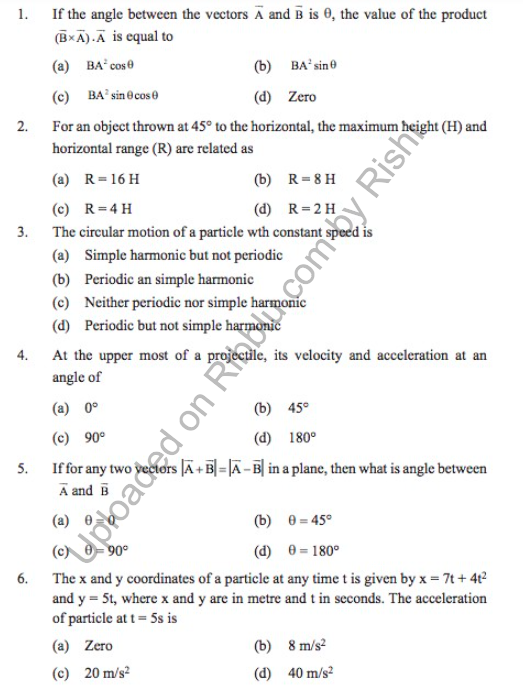Physics Multiple choice Questions for Class 11 Chapter Wise with Answers PDF Free Download is going to be an integral part of preparation to score good marks in their CBSE board examination. Students can Practice CBSE Class 11 Physics Multiple Choice Questions with Answers to improve your score in Board Exams. All these Objective Questions resources have been shared by various students and teachers.
Physics Multiple Choice Questions for Class 11 with Answers Pdf Download
Physics MCQ For Class 11 Chapter wise with Answers are a critical resource for the CBSE board exam preparation. Aspirants who intent to secure high grades in the CBSE class 11th board exam can use the Multiple choice questions for physics subject to practice. It is the best method to improve the final result. Along with that it helps the students to increase the overall understanding in the subject.
Here’s the list of chapters on the “Physics – Class 11” subject covering all chapter based objective Questions. You can practice the MCQs chapter by chapter starting from the 1st chapter or you can jump to any chapter of your choice.
- MCQ Questions Class 11 Physics Chapter 15 Waves
- MCQ Questions Class 11 Physics Chapter 14 Oscillations
- MCQ Questions Class 11 Physics Chapter 13 Kinetic Theory
- MCQ Questions Class 11 Physics Chapter 12 Thermodynamics
- MCQ Questions Class 11 Physics Chapter 11 Thermal Properties of Matter
- MCQ Questions Class 11 Physics Chapter 10 Mechanical Properties of Fluids
- MCQ Questions Class 11 Physics Chapter 9 Mechanical Properties of Solids
- MCQ Question Answers Class 11 Physics Chapter 8 Gravitation
- MCQ Question Answers Class 11 Physics Chapter 7 System of Particles and Rotational Motion
- MCQ Question Answers Class 11 Physics Chapter 6 Work, Energy and Power
- MCQ Question Answers Class 11 Physics Chapter 5 Laws of Motion
- MCQ Question Answers Class 11 Physics Chapter 4 Motion in a Plane
- MCQ Question Answers Class 11 Physics Chapter 3 Motion in a Straight Line
- MCQ Question Answers Class 11 Chemistry Chapter 2 Structure of Atom
- MCQ Question Answers Class 11 Physics Chapter 1 Physical World

CLASS 11 PHYSICS MULTIPLE CHOICE QUESTIONS QUIZ
If the tension in the cable supporting an elevator is equal to the weight of elevator, the elevator may be
(a) going up with increasing speed
(b) going down with increasing speed
(c) going up with uniform speed
(d) elevator falls freely under gravity
A graph is drawn with a force along y-axis and time along x-axis. The area
under the graph represent–
(a) Momentum
(b) Couple
(c) Moment of the force
(d) Impulse of the force
If two forces are acting at a point such that the magnitude of each force is
2N and the magnitude of their resultant is also 2N, then the angle between
the two forces is
(a) 120°
(b) 60°
(c) 90°
(d) 0°
A particle revolves round a circular path. The acceleration of the particle is
inversely proportional to–
(a) radius
(b) velocity
(c) mass of particle
(d) both (b) & (c)
If Maximum and minimum values of the resultant of two forces acting at a
point are 7N and 3N respectively, the smaller force is equal to
(a) 4N
(b) 5N
(c) 3N
(d) 2N
A man is squatting on the ground gets straight up and stand. The force of
reaction of ground on the man during the process is
(a) constant and equal to ‘mg’ in magnitude.
(b) constant and greater than ‘mg’ in magnitude.
(c) variable but always greater than ‘mg’
(d) at first greater than ‘mg’ and later becomes equal to ‘mg’
A uniform chain of length 2m is kept on a table such that a length of 60 cm
hangs freely from the edge of the table. The total mass of the chain is 4 kg.
What is the work done in pulling the entire chain on the table?
(a) 7.2 J
(b) 3.6 J
(c) 120 J
(d) 1200 J
If the linear momentum is increased by 50%, then kinetic energy will
increase by
(a) 50%
(b) 100%
(c) 125%
(d) 25%
A block having mass ‘m’ collides with another stationary block having mass
2m. The lighter block comes to rest after collision. If the velocity of first
block is V, than the value of co-efficient of restitution will be
(a) 0.5
(b) 0.4
(c) 0.6
(d) 0.8
A body of mass 50 kg is at rest. The work done to accelerate it by 20 m/s in
10 s is
(a) 103 J
(b) 104 J
(c) 2×103 J
(d) 4×104 J
A spring of force constant 800 Nm–1 has an extension of 5 cm. The work done
in extending it from 5 cm to 15 cm is
(a) 16 J
(b) 8 J
(c) 35 J
(d) 24 J